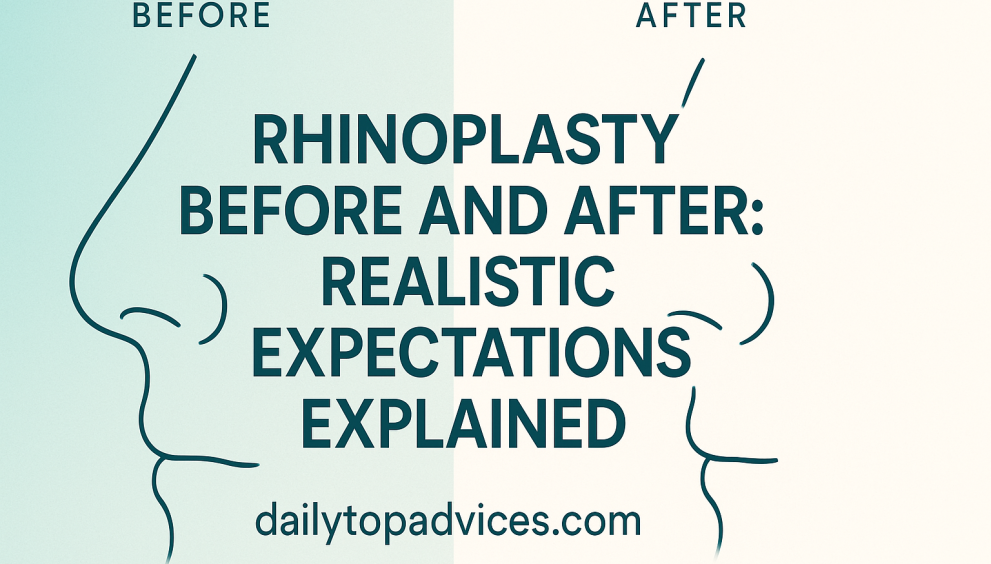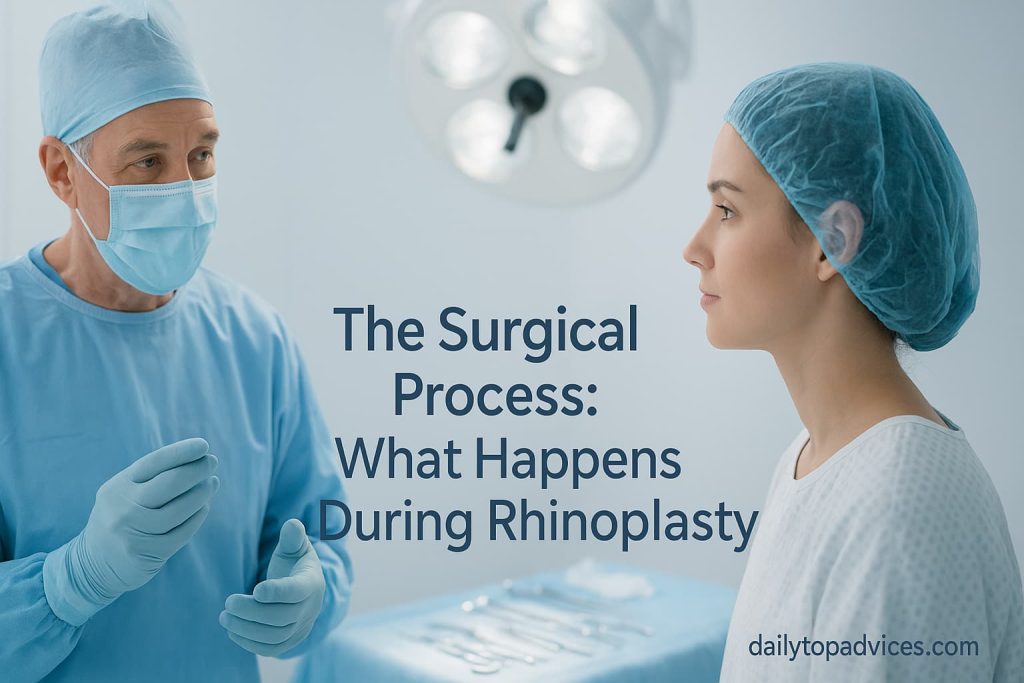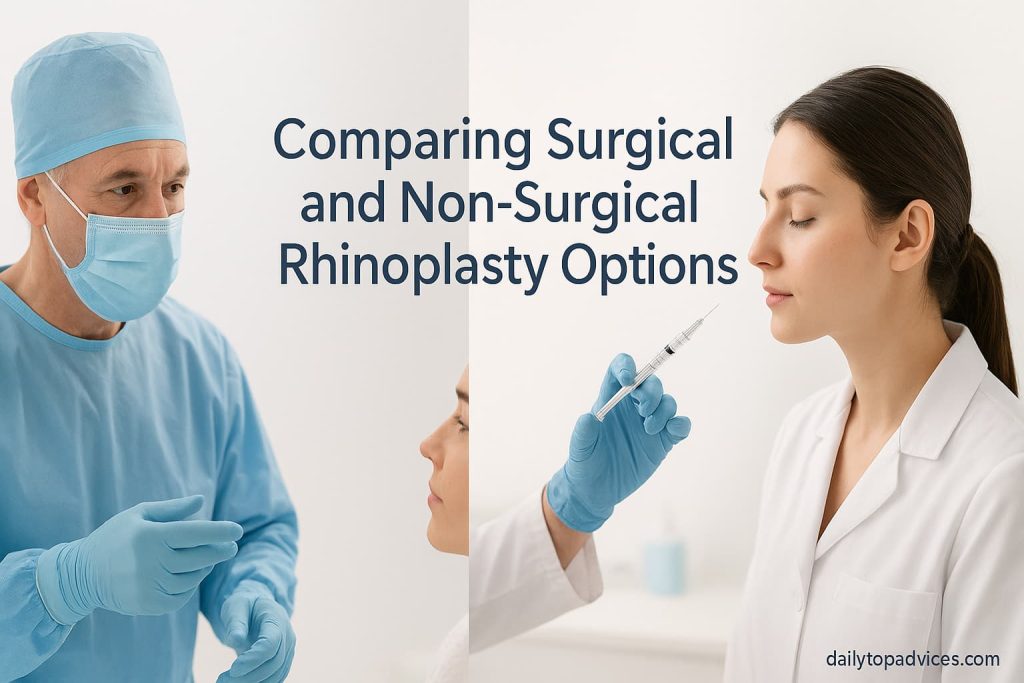Rhinoplasty Before and After: Realistic Expectations Explained

Understanding Rhinoplasty, More Than Just a “Nose Job”
Rhinoplasty, commonly known as a nose job, is among the top five cosmetic surgeries performed worldwide. According to the American Society of Plastic Surgeons, more than 352,000 rhinoplasty procedures were conducted in the U.S. in 2023 alone, highlighting its enduring popularity as both a cosmetic and functional surgery.
The concept of rhinoplasty before and after goes beyond just aesthetic enhancement. It’s a transformative process that involves structural modifications to the nose for better balance, breathing, and confidence. Surgeons often reshape the bone and cartilage to achieve a harmonious appearance that complements facial features.
Patients often come with emotional and psychological motivations. Studies published by the National Library of Medicine show that over 80% of patients report increased self-esteem following rhinoplasty, demonstrating that the outcome is as much emotional as it is physical. Understanding what’s realistic before the operation can prevent disappointment and ensure satisfaction afterward.
What to Expect Before Rhinoplasty: Consultation and Preparation
Before undergoing surgery, a thorough consultation is essential. This stage involves a discussion about expectations, health history, and an evaluation of nasal anatomy. Surgeons use 3D imaging and digital morphing tools to help patients visualize their potential “after” results. However, experts emphasize that these images represent possibilities, not guarantees.
During the preoperative stage, patients are advised to:
- Stop smoking at least 2–3 weeks before surgery to improve healing.
- Avoid blood-thinning medications (like aspirin).
- Maintain realistic goals and understand anatomical limits.
Many patients researching rhinoplasty before and after photos online develop overly idealistic expectations. While these photos can be useful references, every individual’s nasal structure, skin thickness, and healing process differ significantly. The American Board of Facial Plastic and Reconstructive Surgery advises focusing on personalized outcomes rather than comparison with celebrity results.
The Surgical Process: What Happens During Rhinoplasty

Rhinoplasty can be performed using either an open or closed technique. The open approach involves a small incision across the columella (the tissue between the nostrils), while the closed method hides incisions inside the nostrils. The choice depends on the complexity of the surgery and the surgeon’s assessment.
Under anesthesia, surgeons reshape cartilage and bone to refine the nasal profile, correct humps, narrow the bridge, or adjust the tip. Functional rhinoplasty may also include septoplasty to improve breathing.
Procedures typically last 1.5 to 3 hours, and patients return home the same day. As with any surgery, some discomfort, swelling, and bruising are normal. When reviewing rhinoplasty before and after transformations, remember that the immediate postoperative appearance doesn’t reflect final results, it can take several months for the swelling to subside and the true shape to appear.
Recovery Phase: What the “After” Period Really Looks Like
The recovery process is where most expectations need careful management. During the first week, swelling and bruising around the eyes and cheeks are common. Cold compresses and keeping the head elevated help minimize discomfort. Most patients resume light activities after 10–14 days, though strenuous exercise should be avoided for at least four weeks.
Here’s a general healing timeline:
- Week 1: Splint removal, reduced bruising.
- Month 1: Majority of swelling resolves.
- Month 3–6: Nasal definition improves noticeably.
- Month 12: Final results become visible.
According to the Cleveland Clinic, roughly 90% of swelling disappears within 3–6 months, but subtle refinements continue for up to a year.
When evaluating rhinoplasty before and after photos, it’s important to understand that these results usually show patients at least six months to a year post-operation, not immediately after surgery.
Common Misconceptions About Rhinoplasty Outcomes
Many individuals assume that rhinoplasty can create a “perfect” nose, but perfection is subjective. The main goal is facial harmony, not isolation of one feature.
Myth 1: “My nose will look exactly like the model I showed my doctor.”
Reality: Surgeons can use the photo as a reference, but results depend on your anatomy, tissue thickness, and healing pattern.
Myth 2: “I’ll see instant results after bandage removal.”
Reality: True aesthetic refinement may take up to 12 months to stabilize.
Myth 3: “Rhinoplasty results last forever.”
Reality: Aging, trauma, or even lifestyle factors can subtly alter nasal contours over time.
Understanding these facts about rhinoplasty before and after ensures a realistic mindset and higher long-term satisfaction rates.
Realistic Expectations and Psychological Readiness
One key aspect surgeons emphasize is mental preparation. Cosmetic enhancement affects perception and self-image. According to the Journal of Plastic and Reconstructive Surgery, up to 10% of candidates seeking rhinoplasty have unrealistic expectations or underlying body image concerns. Surgeons often screen for psychological readiness to ensure the patient’s motivations are healthy and attainable.
During the consultation, it’s crucial to communicate openly about desired changes. Many plastic surgeons use morphing software and computer-generated previews to set realistic expectations. However, ethical doctors remind patients that surgical precision doesn’t always guarantee emotional satisfaction.
In reviewing your own rhinoplasty before and after transformation, patience and self-acceptance play equal roles to surgical skill in achieving a happy outcome.
Long-Term Care and Maintenance After Rhinoplasty
After the initial recovery phase, patients must maintain nasal health. Avoid wearing glasses for 4–6 weeks, as they can distort healing cartilage. Protect the nose from sun exposure since UV rays can darken scars.
Over time, most patients notice improved confidence and breathing ease, especially if functional corrections were performed. Surgeons recommend annual follow-ups for assessment, as subtle adjustments may sometimes be needed.
It’s also vital to remember that the nose continues to mature slightly over the years. Therefore, rhinoplasty before and after pictures taken one year apart often show continued softening and natural contour improvement.
Comparing Surgical and Non-Surgical Rhinoplasty Options

In recent years, non-surgical rhinoplasty (also called liquid rhinoplasty) using dermal fillers has gained popularity. It’s minimally invasive and offers temporary contouring benefits. According to Harvard Health Publishing, results can last up to 12 months, depending on filler type and metabolism.
However, non-surgical methods cannot reduce nose size or correct breathing issues, they only camouflage irregularities. For permanent structural changes, traditional surgical rhinoplasty remains the gold standard. Patients reviewing rhinoplasty before and after comparisons should understand these distinctions to make informed decisions.
Key Takeaways: Setting Realistic “Before and After” Expectations
| Phase | What to Expect | Notes |
| Before Surgery | Consultation, imaging, expectation setting | Prioritize medical history and communication |
| Surgery Day | 1.5–3 hours procedure | Choose an experienced, board-certified surgeon |
| First Week | Swelling, bruising, rest | Follow recovery instructions closely |
| 1–6 Months | Gradual improvement, definition forms | Avoid heavy exercise and trauma |
| After 1 Year | Final contour visible | Evaluate true long-term satisfaction |
When looking at rhinoplasty before and after transformations, remember that every patient’s journey is unique. A skilled surgeon, realistic goals, and proper recovery habits ensure safe and satisfying results that enhance both appearance and self-confidence.
Click here at Daily Top Advices to read more informational blogs.
FAQs About Rhinoplasty Before and After
Q1: How long does it take to see final rhinoplasty results?
Most patients see about 80–90% improvement by six months, but subtle refinements continue for up to a year.
Q2: What should I avoid after rhinoplasty?
Avoid strenuous activity, glasses on the nose, swimming, and direct sun exposure for at least 4–6 weeks to protect healing tissue.
Q3: Can I combine rhinoplasty with other facial surgeries?
Yes, procedures like chin augmentation or facelift can be combined for balanced facial aesthetics, but only under expert guidance.
Q4: Are non-surgical rhinoplasty results permanent?
No, filler-based rhinoplasty lasts 6–12 months. It’s ideal for temporary adjustments, not structural reshaping.
Q5: What’s the average cost of rhinoplasty?
In the United States, the average cost ranges from $5,000 to $10,000, excluding facility and anesthesia fees, according to the American Society of Plastic Surgeons.
References
American Society of Plastic Surgeons — Rhinoplasty procedural statistics 2023
Cleveland Clinic — Recovery timelines and swelling duration
Harvard Health Publishing — Non-surgical rhinoplasty overview
American Board of Facial Plastic and Reconstructive Surgery — Guidelines for patient expectations
Journal of Plastic and Reconstructive Surgery — Psychological assessment in cosmetic surgery
National Library of Medicine — Studies on patient satisfaction post-rhinoplasty


 English
English 



















